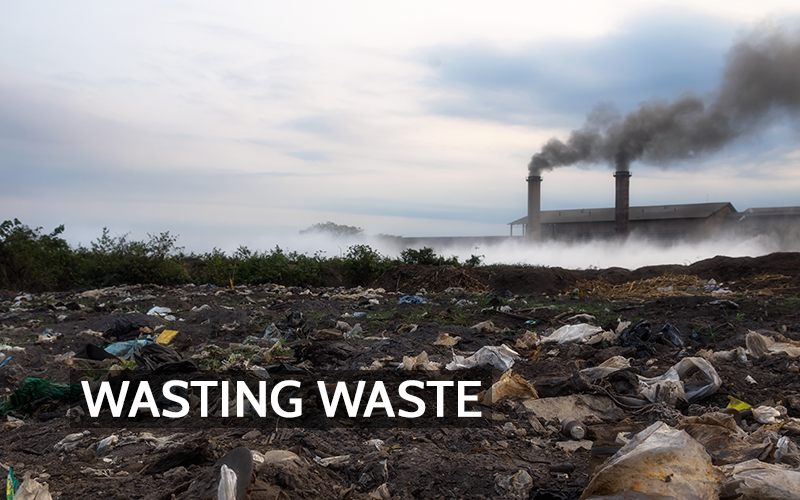In many parts of the world, burning trash remains a prevalent—yet dangerously overlooked—source of air pollution. While waste incineration may seem like a quick solution to the growing mountains of garbage, the practice releases a cocktail of harmful airborne pollutants. These emissions degrade local air quality, harm public health, and contribute to climate change. Despite growing awareness, the open burning of waste persists in low-income regions and urban peripheries, where infrastructure gaps and waste management challenges collide.
This article explores how burning trash affects air quality, identifies global hotspots for this problem, and examines innovative approaches—like pyrolysis and energy recovery—that aim to turn waste into a cleaner resource.
Trash Burning: A Global and Persistent Air Quality Threat
According to the World Bank, over 2 billion metric tons of municipal solid waste are generated each year, with at least 33% of that not managed in an environmentally safe manner. In many developing countries, open burning is still used as a primary method to reduce waste volume.
This practice emits an array of hazardous pollutants including:
-
Particulate Matter (PM2.5 and PM10): Fine particles that penetrate deep into the lungs and bloodstream, causing respiratory and cardiovascular issues.
-
Dioxins and Furans: Toxic compounds formed when plastic and other synthetic materials are burned. These are persistent organic pollutants linked to cancer, endocrine disruption, and immune system damage.
-
Carbon Monoxide (CO): A colorless, odorless gas that can impair oxygen delivery in the body.
-
Volatile Organic Compounds (VOCs) and Polycyclic Aromatic Hydrocarbons (PAHs): Both contribute to ground-level ozone formation and smog.
The World Health Organization (WHO) has reported that outdoor air pollution causes an estimated 4.2 million premature deaths annually, with waste burning playing a significant role in urban and peri-urban areas in South Asia, Africa, and Latin America.
Global Hotspots for Open Waste Burning
India: In cities like Delhi and Kanpur, the combination of agricultural burning, vehicle emissions, and trash burning creates dangerous air pollution spikes, particularly during winter months. Informal settlements often resort to burning waste due to the lack of regular municipal collection services.
Nigeria: In Lagos, where the population exceeds 20 million, over 50% of the city’s waste is managed informally, often through burning. This contributes to severe local air pollution and health risks, particularly in vulnerable communities.
Philippines: Despite the country’s Ecological Solid Waste Management Act of 2000, which bans open burning, enforcement remains weak. Informal recyclers and impoverished communities still rely on open incineration to manage waste and extract recyclable metals.
Guatemala and Honduras: In many rural areas, household waste is burned in backyard pits due to a lack of municipal services. Satellite imagery has identified frequent thermal anomalies consistent with open burning activity in Central America.
Pyrolysis: A Cleaner Path to Trash Conversion
One of the more promising technologies for mitigating waste-burning emissions is pyrolysis, a thermochemical decomposition of organic material in the absence of oxygen. Unlike open burning or traditional incineration, pyrolysis operates in a controlled environment, limiting the formation of harmful byproducts.
During pyrolysis, waste is heated to temperatures between 350°C and 700°C, breaking it down into:
-
Bio-oil: A combustible liquid that can be refined into fuel.
-
Syngas: A mix of hydrogen, carbon monoxide, and methane, used for electricity generation or as an industrial feedstock.
-
Biochar: A carbon-rich solid used in soil conditioning or carbon sequestration.
While pyrolysis can be applied to biomass, plastic waste, and even tires, it’s important to note that it still produces emissions. The key difference lies in emission control and energy recovery. When implemented with advanced filtering systems and under strict regulatory oversight, pyrolysis offers a lower-emission alternative to uncontrolled burning.
While effective adoption of this technology is prohibitively expensive to the places that need it the most; several nations are investing in pyrolysis infrastructure while researching economic improvements in its deployment:
-
Japan: Operates over 100 pyrolysis facilities, many of which process plastic waste and recover energy.
-
Germany: Incorporates pyrolysis into circular economy models, using recovered carbon for industrial applications.
-
India: Is piloting pyrolysis systems for municipal solid waste in cities like Pune and Chennai, in collaboration with private companies and research institutes.
Other Approaches to Reduce Trash Burning Emissions
While pyrolysis holds promise, a multifaceted approach is needed to phase out trash burning globally. These strategies include:
1. Improved Waste Collection and Infrastructure
Cities must invest in more comprehensive waste collection systems, especially in dense urban and abutting rural zones. Expanding recycling programs and organic waste composting can divert significant volumes away from open burning.
2. Community Education and Incentives
Behavior change campaigns have proven successful in parts of Nepal and Kenya, where community outreach reduced the frequency of backyard burning. Incentivizing proper disposal through community-based waste cooperatives can also drive positive change.
3. Ban and Enforcement Mechanisms
Regulatory frameworks that prohibit open burning must be enforced. Policies must be paired with viable alternatives—such as accessible drop-off centers, recycling hubs, and subsidies for clean waste-to-energy technologies.
4. International Partnerships
Programs like the United Nations Clean Air Initiative and the Climate and Clean Air Coalition are working to reduce short-lived climate pollutants by tackling open burning. These partnerships often involve technical support, funding, and policy development.
Turning Pollution into Opportunity
Burning trash continues to degrade air quality around the world, placing an undue burden on marginalized communities and contributing to global climate concerns. Yet within this crisis lies an opportunity. Technologies like pyrolysis, coupled with strategic policy interventions, infrastructure development, and community engagement, can offer a cleaner path forward.
As global waste generation is projected to increase by 70% by 2050, the need for sustainable waste management solutions has never been more urgent. Combating the practice of burning trash is essential not just for cleaner air—but for a healthier and more equitable future.
Related AirQuality.News Article:
Air Pollution in International Waters
References:
- https://openknowledge.worldbank.org/entities/publication/d3f9d45e-115f-559b-b14f-28552410e90a
- https://www.who.int/news-room/fact-sheets/detail/ambient-(outdoor)-air-quality-and-health
- https://www.unep.org/ietc/resources/publication/waste-energy-considerations-informed-decision-making
- https://www.ccacoalition.org/projects/open-waste-burning-prevention
- https://pubmed.ncbi.nlm.nih.gov/28886975/
Image Ref: AdobeStock_152543615


